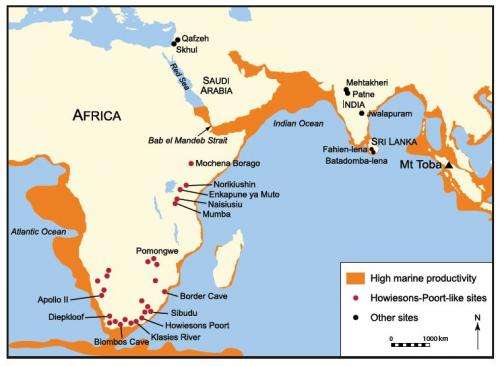June 11, 2013 report
New study refutes claims of early humans in India prior to Mount Toba eruption

(Phys.org) —A team of British researchers has published a paper in Proceedings of the National Academy of Sciences refuting claims made by a research team in 2007 suggesting that humans migrated to India as early as 75,000 years ago. In their paper, they say mtDNA and new archeological evidence indicates that modern humans arrived in India approximately 50 to 55 thousand years ago.
For many years scientists believed modern humans had migrated from Africa to India approximately 50,000 to 60,000 years ago. Then in 2007, a team of archeologists discovered some stone tools that had apparently been made by modern human ancestors in a site in southeastern India, which appeared to have been from a much earlier time. The team reported finding such tools both above and below the ash line caused by the massive eruption of Mount Toba approximately 74,000 years ago. The explosion from the volcano is believed to have sent so much ash into the air that the planet was cooled for several years thereafter.
In this new effort, the researchers sought to settle the arguments about the Indian migration timeline once and for all. To do so, they collected mitochondrial DNA samples from 817 volunteers all across the Eurasian subcontinent, while also reexamining the stone tools that had originally set off the debate.
In studying the mtDNA, the researchers concluded that modern humans had settled in the area no earlier than 55,000 to 60,000 years ago. The evidence indicated that early humans had settled along the coast first, then traveled inland following rivers. Such a timeline indicates that modern humans didn't migrate to India till well after the eruption of Mount Toba.
Meanwhile, others on the team investigating the stone tools discovered by the earlier team found that they were very likely the work of Neanderthals, not early modern humans. They note that the author of the original study claiming the stones had been made by early humans had withdrawn the paper with the suggestion that the tools were likely made by an unidentified group of archaic people living in the area at the time.
Taken together, the team says their findings should once and for all end the debate regarding the migration timeline for modern humans moving into India.
More information: Genetic and archaeological perspectives on the initial modern human colonization of southern Asia, PNAS, Published online before print June 10, 2013, doi: 10.1073/pnas.1306043110
Abstract
It has been argued recently that the initial dispersal of anatomically modern humans from Africa to southern Asia occurred before the volcanic "supereruption" of the Mount Toba volcano (Sumatra) at ∼74,000 y before present (B.P.)—possibly as early as 120,000 y B.P. We show here that this "pre-Toba" dispersal model is in serious conflict with both the most recent genetic evidence from both Africa and Asia and the archaeological evidence from South Asian sites. We present an alternative model based on a combination of genetic analyses and recent archaeological evidence from South Asia and Africa. These data support a coastally oriented dispersal of modern humans from eastern Africa to southern Asia ∼60–50 thousand years ago (ka). This was associated with distinctively African microlithic and "backed-segment" technologies analogous to the African "Howiesons Poort" and related technologies, together with a range of distinctively "modern" cultural and symbolic features (highly shaped bone tools, personal ornaments, abstract artistic motifs, microblade technology, etc.), similar to those that accompanied the replacement of "archaic" Neanderthal by anatomically modern human populations in other regions of western Eurasia at a broadly similar date.
Journal information: Proceedings of the National Academy of Sciences
© 2013 Phys.org





















